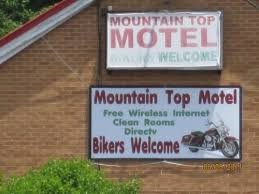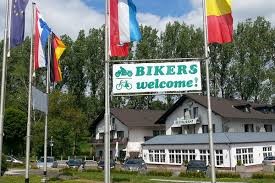By Eddie Pipkin
This week we feature another entry from Dr. Phil Maynard’s observations from the road! A few weeks ago, Phil (our intrepid  leader) was on a break in the mountains of Western North Carolina – specifically the lovely Maggie Valley area – and he noticed that every single roadside motel featured a sign that welcomed bikers. This hilly terrain, snug against the Great Smoky Mountains National Park and the Blue Ridge Parkway, is famous for its motorcycle rides, so it makes sense that local inn keepers would offer hospitality to all those Harley owners, but what caught Phil’s eye was the one spot that offered more than warm words on a sign – they had a covered areas for parking bikes. It got Phil to thinking about the difference between those ubiquitous church signs that “welcome all,” and the churches that move beyond friendly slogans to offer tangible hospitality to specific folks in their communities.
leader) was on a break in the mountains of Western North Carolina – specifically the lovely Maggie Valley area – and he noticed that every single roadside motel featured a sign that welcomed bikers. This hilly terrain, snug against the Great Smoky Mountains National Park and the Blue Ridge Parkway, is famous for its motorcycle rides, so it makes sense that local inn keepers would offer hospitality to all those Harley owners, but what caught Phil’s eye was the one spot that offered more than warm words on a sign – they had a covered areas for parking bikes. It got Phil to thinking about the difference between those ubiquitous church signs that “welcome all,” and the churches that move beyond friendly slogans to offer tangible hospitality to specific folks in their communities.
Of course, there is nothing wrong with offering words of welcome. It is a fundamental principle of Christian life to welcome everybody, and churches sincerely communicate this sentiment (both as an invitation to community and — equally usefully — as a public reminder to the members of congregations who post these words that this is one of our fundamental values). It is important to give congregations practical reminders about what a true “welcome” looks like and what their responsibility is as disciples and congregational representatives in offering such a welcome. Because every single church on the block has a sign that says “welcome all,” visitors are understandably skeptical about whether that is true or just an empty slogan.
In the case of the motel that offers more, however, there is a whole  other level of hospitality in evidence. This motel provided a visible assurance that, not only are bikers and their money welcome, the folks in charge have gone out of their way to meet the needs of the biking community in very specific and practical ways. They provided covered areas where bikers could park their machines to keep them out of the weather — and these safe storage areas were clearly visible from the highway. Bikers don’t have to take their word for the hospitality that will be offered. They can see it with their own eyes.
other level of hospitality in evidence. This motel provided a visible assurance that, not only are bikers and their money welcome, the folks in charge have gone out of their way to meet the needs of the biking community in very specific and practical ways. They provided covered areas where bikers could park their machines to keep them out of the weather — and these safe storage areas were clearly visible from the highway. Bikers don’t have to take their word for the hospitality that will be offered. They can see it with their own eyes.
It is rare that churches provide such visible assurances to those passing by on the street. Often, churches give off a “members only” vibe when viewed by passersby — sometimes, literally, there is signage to keep out undesirables. Even areas that could be a community asset, like playgrounds, fields, gardens, and even parking lots, are rarely presented to the community as resources for communal use. [And although I know there are Board of Trustees members having a stroke as they read those words, some churches can and do figure out the logistical hurdles to become the neighborhood’s front porch or backyard.]
Even more powerful, however, is targeting specific amenities, spaces, and ministries to embrace specific needs in specific communities. It’s all about context. Embracing context is what sets local churches apart from the generic denominational noise and helps them stand out as faith communities interested in meeting the needs of the locale they call home.
Tom Bandy wrote extensively about these opportunities for ministry in his book, See, Know & Serve the People Within Your Reach. In it he documents the unique environments of individual local churches within the great diversity of settings (small towns, urban centers, rural enclaves, older congregations, family-centric suburbs, diverse cultures, and changing communities). While we may be diligent at studying up on across-the-board “best practices,” we may fail to identify the opportunities that make us unique in our individual context.
Sometimes, our context is part of the fabric of changes that are percolating through society-at-large. Bandy writes about the changing way we all eat meals, and how we should think about that shift as we develop hospitality strategies:
A new hospitality alternative is emerging today, especially in church plants, outreach ministries and innovative churches. . . . [T]hey all share a life experience that is either fast-paced or unpredictable. They often rely on fast food or eat on the run. . . .
Mid-week church dinners don’t work the way they used to! Maybe we design a new thing that embraces the spirit of the cultural shift, or maybe we intentionally stress the throwback nature of our communal meal time, but either way, we are careful to be in tune to the needs of the families we are serving.
When it comes to worship, we need to be even more finely attuned to the demographics and cultural expectations of our communities — especially if we are in an area where cultural and demographic shifts are taking place. Bandy writes,
Good worship is whatever works to bring people into the real presence of Christ. . . . [For example,] transformational worship results in freedom from
addictions, participation in 12-step programs, radical attitude shifts. . . .
We need to be relevant, which is not just good marketing or a solid growth strategy for struggling congregations. Knowing the context of our community and addressing the needs and preferences of that context means that we truly welcome those people. If our community is smack dab in the middle of America’s opioid crisis, and we have no addiction ministries — no support groups or Celebrate Recovery worship services — are the individuals and families struggling with that life-shattering issue truly welcome? Suffice it to say, if Jesus was ministering in current day America, he would be right in the middle of that suffering.
Imagine, for a moment, a church with a sign out front that said, “Addicts Welcome.” That would be a bold statement. There are, however, a thousand different contexts for a thousand different churches in a thousand disparate communities.
Imagine these potential signs:
- Immigrants welcome.
- Senior citizens welcome.
- Families with autistic children welcome.
- Debtors welcome.
- Lonely people welcome.
- Skeptics welcome.
- Single parents welcome.
- Sick people welcome.
- Survivors welcome.
- Grieving people welcome.
- Dysfunctional families welcome.
- Grieving people welcome.
- People dealing with depression and anxiety welcome.
- People who don’t know anything about church welcome.
Or course, if you are going to welcome these people groups, you better have some ministry and worship accommodations on hand to bring credibility to your hopeful words. If hurting people take a chance on you and your invitation, if they work up the courage to walk through your door, will they able to tell that you mean it? Will they know you value them?
Let’s be frank: it’s much easier to be generally welcoming — to offer a smile and a ministry pamphlet — than it is to embrace this concept of the targeted welcome. It is much more work to focus your welcome on distinct needs. It is, however, work that pays huge dividends. For those serving, it helps us clarify the vision of whom we are called to serve and how we can employ our gifts in pursuit of this service. For those being served, it is a powerful opportunity to experience the acceptance, faithfulness, and love of a community which lives out the words of Jesus.
How does your congregation welcome specific groups with specific needs? Do you stick to a well-intentioned generic welcome? Or do you offer visible signs of welcome to specific folks? Do you respond to the unique context of your community? How? Share your own stories and fresh ideas in the comments section.


I believe this is an excellent article with a lot of good information.
I recently began working a ministry position in different church. My key question over and over is described this town. Even if it’s 10 miles away from my home or former church it has a different makeup and need. Explain to me what is special, unique or needed in this town so that we can plan and organize our outreach and programming to best become a vital part of the community.
So far, I’m doing well at refocusing our ministries and discipleship on the true needs of the current congregation. Not the congregation of hopes. I still have not identified the true key to this community but have begun to prepare, train and implement new ideas so we will be ready to put that personal welcome shingle out.
“Grateful Dorian Survivors Welcome”
Tbat’s a good one!